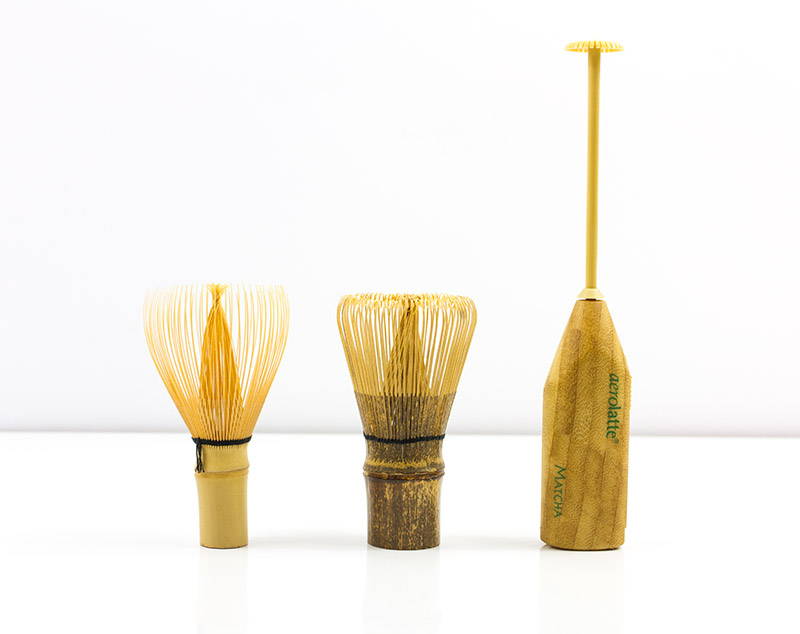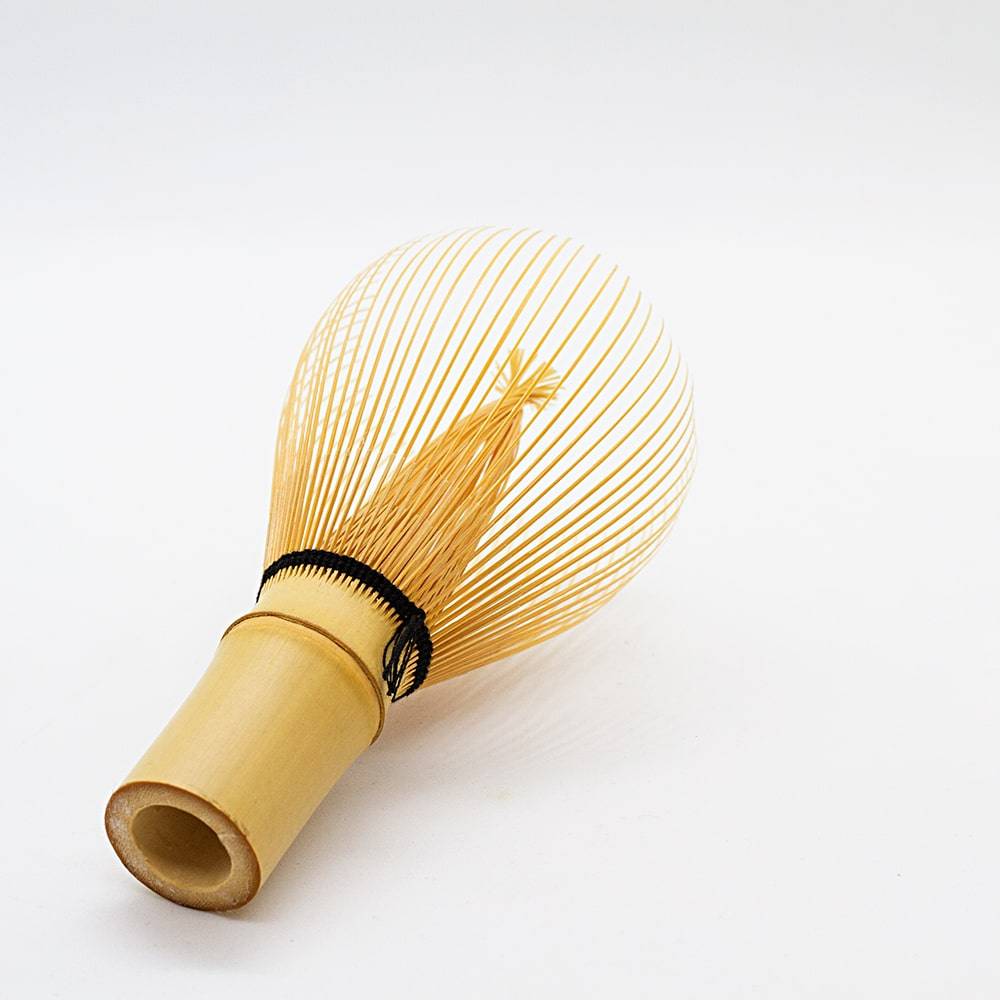Matcha Whisk Buyers Guide on Selecting, Using and Maintaining a Whisk
In this blog we attempt to answer the most frequently asked questions regarding the most important tool for preparing Matcha tea - the bamboo matcha whisk commonly known as the Chasen in Japanese.
But first, let's talk briefly about the origins and history of the Chasen.
Dating back to around 600 years ago, the first Japanese Chasen was crafted in Takayama Japan.
In the beginning, tea ceremony was reserved for only the most prestigious people in Japanese society. But there was a man by the name of Murata Juko, who wanted to introduce the beauty and philosophy of tea ceremony to the masses.
With this in mind, Murata commissioned Takayama Minbunojo Nyudo Sosetsu to craft Chasens for tea ceremony. Amazed by the beauty of Takayama's whisks, Murata Juko gifted some of Takayama's Chasens to the emperor who was also astounded by the beauty and craftsmanship.
Over time, the whisks became widely popular and became known as Takayama Chasen.
The Chasen itself is made from a single piece of young bamboo with tines measuring only 0.1 mm. The craftsmanship is so intricate that the Chasen production is limited to only a few each day.
Today, the majority of whisk production is handled in China. Some whisks are handmade in China and some China made whisks are machine made.
Outside of Japan, it is still possible to purchase a Japanese made Takayama whisk, however, due to the decline in Japanese whisk makers, original Takayama whisks are increasingly harder to buy and often only reserved to the Japanese market.
Overview

If you are preparing matcha the traditional way and drinking the matcha as a pure tea, then the answer is yes. Alternatively, if you are using matcha as an additive to a breakfast smoothie, then simply blending it in with all the other ingredients is absolutely fine.
You should whisk matcha tea because matcha powder itself does not dissolve in water. When you add matcha powder to water, you'll notice that small clumps will form. Even stirring matcha with a teaspoon won't help reduce the clumps. Instead, whisking matcha with a purpose built whisk will agitate the clumps and allow the clumps in your matcha green tea to break up.
The individual springy tines of the bamboo whisk work to aerate the powder tea. When the powder tea and water is enriched with oxygen a layer of foam will appear and the aromas and tannins of the tea are released.
Whisking matcha plays a pivotal role in reducing the bitterness and increasing the creaminess and smoothness of this powder green tea.
Missing this important step will reduce your appreciation of even a high grade matcha green tea.
Proper care and maintenance of your bamboo whisk can prolong the life of the whisk for up to 12 months or more. Bamboo is very delicate and often the signs that it needs to be replaced are fairly obvious on inspection. Over time, the thin tines of the whisk will break off. However, even with a few broken tines, it is still possible to produce foamy matcha. Always inspect for mould growing in areas that are hard to dry, for instance inside the neck of the whisk.
With the demand for matcha growing worldwide, the demand for bamboo whisks has rapidly increased. As a result, there are many inferior, poorly made matcha whisks available in the market today.
The best matcha whisks to buy are manufactured in Japan. In Japan, a Chasen is made by a master craftsman whose technique can be traced to a family lineage of Chasen makers. Whisks made in Takayama Japan are often revered as the best whisk makers in all of Japan.
The most important qualities to look for in a matcha whisk are:
Bamboo quality
The quality of the material has a great effect on the durability of the Chasen. Respected Japanese craftsmen source their bamboo from trusted farms, resulting in high-quality whisks that last longer under the stresses of continued use.
String count
The more strings a whisk has the finer they are, which creates a smoother matcha. You can find Chasen being sold that offer a string count anywhere between 16 and 120. The higher the number, the easier it is to whisk the tea powder into the water and create the soft peak of foam. The lower the number, the longer it will take to whisk.

To whisk matcha effectively will take some practice. In Japan, to become a master of Japanese tea ceremony can take several years of dedication. But for us modern day practitioners, all it takes is practice and a few helpful tips.
1. Season the whisk in hot water for a few seconds so that the tines absorb the water and soften up. Doing this step will give the tines extra spring and lessen the chance of tines breaking.
2. Scoop 1-2g of matcha tea powder into the chawan (Matcha bowl).
3. Start by adding just a small amount of water ( 50 ml ) to the Chawan.
4. Hold the Chawan firmly with one hand and in the first instance start to stir the powder and water combination with few rotations with your whisk. This helps to spread the matcha powder in the Chawan.
5. Next, arch your wrist and whisk the ingredients as quickly as possible using a W-shapped motion. Take care not to let the whisk tines scrape the bottom of the Chawan.
6. When a layer of foam starts to foam consistently raise your whisk slightly and slow your motions to whisk only the surface of the foam. Doing this step will help burst the bigger bubbles in the tea and produce that nice nano foam to give that creamy delicious finish.
You can buy a matcha whisk at most asian grocery stores or asian specialty stores.
Failing that, most online Japanese tea speciality stores sell matcha whisks.
A Matcha Whisk is intricately carved by hand from one piece of aged bamboo.
First, the bamboo's tender inner flesh is removed to make the hollow tube more brittle. Then, using the natural grains of the wood, the maker splits it with a carbon steel knife into a series of matchstick-like spokes.
From there the bamboo is whittled down even more—the sides scraped down to be as thin as paper, the spokes split into infinitesimally smaller tines—and with delicate flicks of the wrist, those tines are then curled into that iconic trapezoidal shape.
There're different kinds of Chasen for different uses. The more tips (prongs) it has, the better froth you will get. Typically Chasen with more prongs is meant for Usucha - thin tea, and the one with less prongs is meant for Koicha - thick tea.
In summary, there are 7 stages of making a Chasen.
Splitting the Bamboo (“Hegi”)
Once the bamboo has been cut to the required length, the first part of the process is to split the bamboo to create the tines. Much like cutting a cake, the bamboo is repeatedly cut in half to create smaller and smaller slices. The number of splits depends on the thickness of the bamboo but ranges from 12 to 24. Once the bamboo has been split, the pulp inside the bamboo is removed and the splits are bent outwards.
Fine Splitting (“Kowari”)
The base tines are split further in much the same way as before to create thinner tines. The final number of tines will depend on the type of whisk being made. The Kazuho whisk that is commonly found in the West has 80 tines. It has 16 base splits, each of which is split further into 10 thinner tines which gives 160 tines in total – an outer ring of 80 tines and an inner ring of 80 tines.
Shaving The Tips (“Ajikezuri”)
The tips of the tines are soaked in hot water to soften them before they are carefully shaved and thinned from the base. The shape of the tip varies depending on the preferences of the tea school. For example, the tips of the tea whisks used by the Mushakouji Senke school are straight, while those used by the Urasenke school are often curved like a fish hook.
Chamfering (“Mentori”)
The edges of each tine are shaved to a 45 degree angle to prevent the matcha powder from sticking to them. This also helps to produce smaller bubbles in the foam.
Threading (“Shita-ami” and “Uwa-ami”)
A thread is run between each tine in order to keep them spread outwards. The tines are bound with thread once (shita-ami) and then once more to securely fix them to the base of the whisk (uwa-ami).
Most matcha whisks are tied with black threads so that any stains from the tea do not stand out although some tea schools use white threads. Yellow thread is used for Buddhist memorial services and red or red and white thread can be used for special celebrations.
Adjustment (“Koshi-narabe”)
A bamboo spatula is used to bring together the inner tines, and generally tidy up the whole head, including the size of the gaps between each tine.
Finishing
The final touches. The shape of the whisk head is perfected and the tines are checked one last time before the whisk is packaged (typically inside a small presentation box) and ready for use.

Your bamboo Matcha whisk can easily attract mould if not cleaned and dried after each use. Run warm water over the whisk with the tines facing down. You can use a bamboo brush to gently remove excess tea from the tines of the whisk.
Wash your whisk immediately after use, otherwise the tea may stain the tines of the whisk. Don't use detergent, just warm water will suffice. Once you have rinsed the whisk, place it on drying rack in a cool dry area of your kitchen. Never put the whisk back in the container if it is still moist as this will only invite mould to grow on your whisk.
We wrote a separate article on how to clean and maintain a matcha whisk
There are many factors that contribute to a good whisk. The tines on a well-made matcha whisk should never be too rigid or stiff. The tines should be precisely shaved thin enough to have an excellent spring effect and at the same time not too thin that the tines break after only a few servings.
The quality of the bamboo and how the bamboo was treated is also another aspect of a good whisk.
If white bamboo is required, the bamboo has to be seasoned over several years before it can be used. During winter, the bamboo is left out in the open in the rice fields around Nara where the exposure to the cold wind and sunlight slowly turns the bamboo white. The bamboo poles are stacked against each other to form small structures similar to a teepee.
It is possible to produce some foam by whisking with a fork. But you will never achieve the foamy consistency when using an original bamboo whisk.
A better common household alternative would be a shaker bottle or mason jar. If you are using hot water, be careful not to burn yourself.
Shaking matcha in a mason jar can actually produce excellent results!
If you don't have a matcha whisk, you can try:
1. Battery operated milk frother.
2. Shaker bottle or mason jar.
If you have never whisked with a Chasen, doing so will give you the opportunity to rediscover the beauty of matcha and deepen your understanding of the Japanese tea ceremony. Purematcha offers a variety of high-quality matcha whisks sourced from well-established Japanese craftsman specialising in the art of making Chasen.

For beginner matcha enthusiasts, Purematcha makes discovering the world of Japanese tea easy with elegant matcha whisk sets that include all the essential tools necessary, including a Chasen, for making matcha in Japan’s traditional style.






